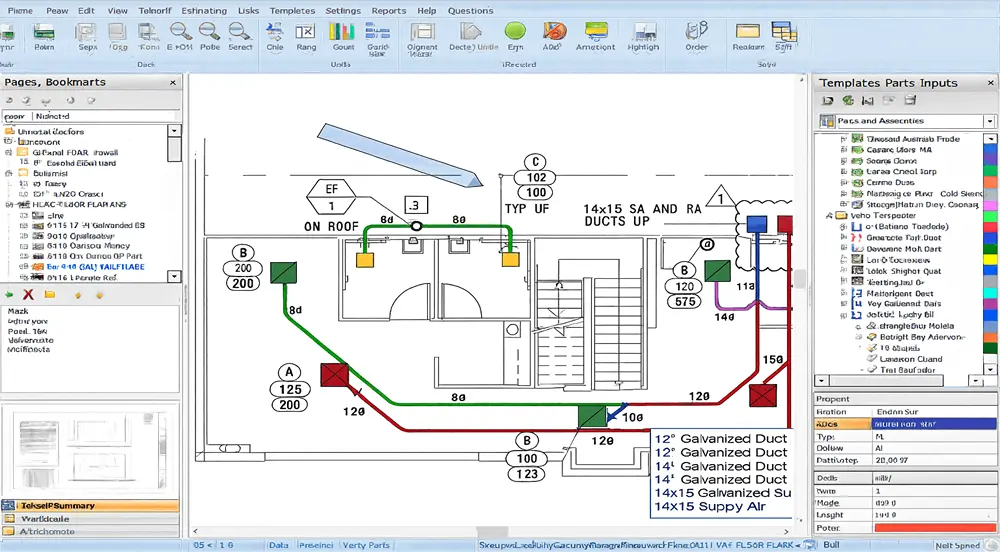Australian builders now depend on advanced Construction Takeoff Software to streamline estimating and improve accuracy. Tools such as CostX, Bluebeam Revu, and PlanSwift automatically extract quantities from drawings, cutting manual errors and boosting productivity across residential, commercial, and civil construction projects.
How Construction Takeoff Software Streamlines Estimating Workflows
Ever wondered why some estimators wrap up bids in half the time? Construction takeoff software automates measurements from digital plans, pulling quantities directly into cost sheets without the endless ruler-and-calculator grind. This shift not only cuts manual errors but also frees your team to focus on value engineering rather than rote data entry.
In practice, I’ve used these platforms on Sydney harbourfront projects where tight deadlines ruled; the software synced real-time updates across remote teams, ensuring everyone worked from the latest revisions. Result? Bids submitted 30% faster, with stakeholders praising the clarity that reduced change orders down the line.
Key Features That Define a Reliable Takeoff Platform
What separates a game-changer from a gimmick in takeoff tools? Look for on-screen digitising that handles layered PDFs effortlessly, coupled with custom assemblies for trade-specific items like rebar or cladding. These aren’t bells and whistles, they’re essentials that align with Australian Standards for precise material breakdowns.
Robust reporting dashboards stand out too, letting you export BOMs in formats compatible with your ERP system. During a recent Melbourne warehouse fit-out, such features helped us forecast conceptual estimates early, spotting potential overruns before they ballooned budgets.
From Manual Takeoffs to Digital Precision: The Real Difference
Picture this: weeks of poring over blueprints with highlighters, only to discover a scale error that throws your entire bid off by thousands. Digital construction takeoff software flips that script, using vector-based scaling to lock in measurements that adapt as plans evolve. The payoff? Quantities that hold up under scrutiny, every time.
On a Brisbane high-rise, switching to digital meant we caught a 15% variance in concrete volumes that manual checks missed, saving over AUD 50,000 in over-ordering. It’s not just speed; it’s the confidence that comes from data you can trust when margins are razor-thin.
How Quantity Surveyors and Estimators Use Takeoff Tools in Practice
Quantity surveyors lean on construction takeoff software to dissect complex site plans, layering in site-specific factors like soil conditions or wind loads for tailored outputs. Estimators, meanwhile, layer these quantities onto historical data, tweaking for regional variances like Queensland’s cyclone-proofing requirements.
Take a Perth commercial strip: We imported survey data into the tool, ran scenario analyses, and adjusted for Construction Cost Forecasting amid rising steel prices. The result was a bid that won the job, with built-in buffers that kept the project on track despite supply hiccups.
Top Construction Takeoff Software You Should Know in 2025
Navigating the 2025 lineup feels like picking the right tool from a crowded shed, each shines in its niche. Here’s a quick comparison of standout options, based on real-world adoption rates where the global market for such software hit USD 2.73 billion this year.Construction Estimating Software Market Size, Growth & Share Report 2030
| Software | Best For | Key Strength | Pricing Model |
|---|---|---|---|
| PlanSwift | General Contractors | Intuitive drag-and-drop assemblies | Subscription from AUD 1,200/year |
| Bluebeam Revu | Collaborative Teams | PDF markup with audit trails | Per-user licensing, ~AUD 400 |
| STACK | Subcontractors | Cloud-based quantity reporting | Free tier; premium AUD 2,500/year |
| Togal.AI | AI-Driven Speed | Automated area detection | Usage-based, starts at AUD 500/month |
| Beam AI | Small Firms | Full automation for 90% time savings | Flat fee ~AUD 1,000/month |
Integration with Estimating and Project Management Software
Seamless handoffs make or break efficiency; construction takeoff software that plugs straight into platforms like Procore or Autodesk BIM 360 turns isolated silos into a unified workflow. Data flows from takeoff quantities to schedules and budgets in one click, minimising rekeying that plagues hybrid setups.
In a Darwin infrastructure rollout, linking takeoff outputs to our PM tool flagged labour mismatches early, adjusting crew allocations before mobilisation. It’s the quiet hero that keeps projects humming, especially when coordinating with offshore partners across time zones.
Common Mistakes When Choosing a Takeoff Software (and How to Avoid Them)
Rushing into a flashy demo without trialling on your actual blueprints often leads to integration headaches later. To sidestep this, map your workflow against the software’s API compatibility upfront; I’ve dodged countless rework cycles by doing just that.
Another pitfall? Ignoring mobile access for site verifications, which strands you with desktop-only limitations. Opt for hybrid apps that sync offline; on a remote WA mine site, this feature let us validate takeoffs against as-builts without signal woes, preserving accuracy amid dust and delays.
How to Evaluate ROI When Investing in Takeoff Technology
Crunching the numbers on construction takeoff software ROI starts with benchmarking your current process, track hours spent on takeoffs now, then project savings against a 25% time reduction typical in digital shifts. Factor in fewer errors, which can reclaim up to 50-75% in productivity gains.Top Construction Quantity Takeoff Software: 2025 ROI Comparison
For a solid evaluation, here’s a simple checklist:
- Baseline your manual takeoff cycle time and error rate.
- Pilot the software on a mid-sized bid for three months.
- Calculate net savings: (Time saved x Hourly rate) minus subscription costs.
We applied this to a Gold Coast resort project, recouping the investment in four bids through sharper wins and leaner ops.
The Future of Digital Takeoffs in Modern Construction
AI isn’t just hype by 2025, it’s embedding predictive analytics into construction takeoff software, forecasting material needs based on weather data or supply chains. Cloud collaboration evolves too, enabling real-time tweaks from fab shops to foremen.
Expect deeper BIM ties, where takeoffs pull from 3D models for clash-free quantities. In upcoming Adelaide rail extensions, early adopters are already using these for dynamic updates, trimming overruns by 20% and setting a benchmark for offshore teams worldwide.


